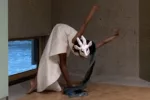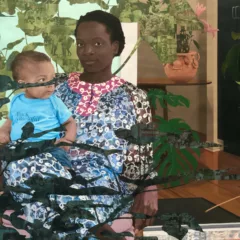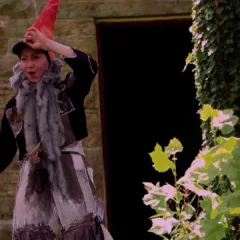(Elizabeth sees the Mike Kelley show at MoMA PS1 with her friend, the West Coast artist Lani Asher, and they talk about the California common denominator to a recent spate of art shows in New York and Philly.–the Artblog editors)
Joining the hipster crowd on a Sunday at PS1, San Francisco artist Lani Asher and I encounter Mike Kelley’s provocative, disturbing childhood themes in a cheerful, kid-friendly setting, circumnavigating strollers, toddlers and babies being lifted to see. Most of the kids giggle and enjoy the spectacle, dazzled by the bright colors, dark spaces, catchy music and fuzzy toys. Shocking video images of fake porn and defecation, sighs, swoons, and screams don’t seem to faze them although the adults periodically turn away.
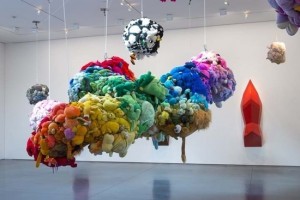
Kelley at PS 1 – Shock, boredom and a lot of guards to protect the works
The most powerful work at PS1 is Horizontal Tracking Shot of Cross Section of Trauma Rooms, as it features private binge-watching (you sit in a corner behind a picket fence of colored panels and are conditioned to expect a carefully measured shock). Sitting in front of the three TVs ensures that you’ll get a certain jolt in a measured space of time, and recalls watching all three doors in “Let’s Make a Deal” right before the prize or dud is unveiled. Kelley’s clock-like audio syncs perfectly with colored rectangles that pass laterally across the screen, and then, at regular intervals, found Youtube footage. Clips of children crying or being tormented appear for one beat, just long enough to grab my attention and upset or unseat me. My shock is the payoff and I feel implicated in the children’s torment through my anticipation.
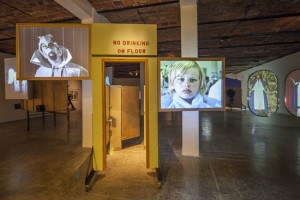
(c) Estate of Mike Kelley
Courtesy of MoMA PS1, NYC.
Installation view of Mike Kelley at MoMA PS1, 2013. Photo: Matthew Septimus.
Lani and I climb the stairs to the second floor, arriving at Day is Done (2004-2005), Kelley’s most ambitious installation. His massive, multimedia, multi-narrative piece seduces, bores and entertains, generating an overlapping and confused sensory immersion. The kids love the chaos and pick up the beat, the collective noise level rises, and I can’t budge from in front of Extra Curricular Activity Projective Reconstruction #2. Three “train-dancers” and the Devil mesmerize me thanks to Kelley’s superb music synced with video and his framing and editing. Yet my attention is also attracted toward zombies and vampires punching the clock in the office next door, Extra Curricular…#3 through #7 and the operatic drama in a Fresno ranch house, Extra Curricula…#8. A guard scolds a mom for trying to wheel her stroller through a pathway made from a toilet stall, part of the Devil Barber scenario Extra Curricular…#25. Lani and I note that there are probably four times as many guards at PS1 as usual, all hired to protect Kelley’s subversive art. Kelley would be amused that they are safeguarding “the banal” and “the taboo,” and that they play their roles in uniform.
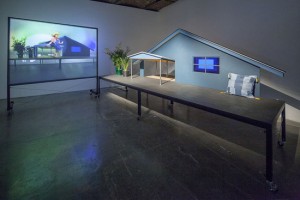
(c) Estate of Mike Kelley
Photo courtesy of MoMA PS1, NYC.
Installation view of Mike Kelley at MoMA PS1, 2013. Photo : Matthew Septimus.
A little California art history
Because installation and performance art dominated the New York and Philadelphia art scenes in 2013 (in addition to Kelley’s show, there was the Paul McCarthy exhibit at the Park Avenue Armory; Chris Burden at The New Museum; and Jason Rhoades at ICA in Philadelphia), Lani and I talked about the California connection.
In the mid-1960s to late-1970s California, art started to overlap with perceptual experimentation. (See **note below for more information).
Lani, who was a contemporary of Mike Kelley’s, got her B.A. from the College of Creative Studies at UC Santa Barbara in 1977, a year before Mike Kelley got his M.F.A. at CalArts. She recalls classes spent “trying to levitate” with John McCracken and “flying upside down in an airplane with James Turrell.” The naughty stuff— drugs, sex, and bodily functions—came into the performance arena at the San Francisco Art Institute in the mid-1980s, at a time when Lani was pursuing her M.F.A. in performance art there.
The older generation artist/performers, McCarthy (USC, SFAI) and Burden (Pomona College, UC Irvine) are still going strong: both taught in California and were leaders when installation took over where performance art left off. McCarthy and Kelley playfully collaborated in Heidi (1992), McCarthy playing the role of “Grandfather” and Kelley the role of the mentally handicapped “Grandson.”
Lani says that Kelley acted as a shaman seeking to heal himself and the culture through exposing society’s dark secrets. I would add that he was also an explorer who didn’t return from the dark side: Kelley committed suicide at 57.
Kelley’s early suburban loathing and later works that feel packaged to sell
Lani grew up in the suburbs of Los Angeles. She and Kelley share a loathing of suburban life and the repression that hides under conformity. I grew up on a Pennsylvania farm and feel that Kelley’s early work from 1991-1999, including Deodorized Central Mass with Satellites and Horizontal Tracking…Rooms is far stronger than the later installations Kandors (2007-2011) and Fortress of Solitude (2011). The latter work references California as the land of make believe, of Walt Disney, of Superman, of trends and actors and bad taste. And though I am impressed with the video of Superman reading Sylvia Plath’s “The Bell Jar” and photographs of Kelley’s first home overlaid with ones of the current occupants, I don’t have a deep emotional investment in them.
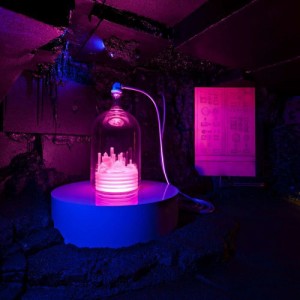
part of the exhibitit, Kandor 10B/Extracurricular Activity Projective Reconstruction #36, 2011, Gagosian Gallery, London
Photo: Fredrik Nilsen
All Kelley works © Estate of Mike Kelley
Courtesy of Mike Kelley Foundation for the Arts
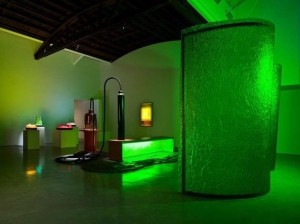
Looking at Kelley’s retrospective, considering the sizable investments made by Gagosian Gallery and Jablonka Galerie, and the pressure to be newer, nastier and ever more attention-grabbing, I would say that Kelley’s later works are not his strongest. I think of the later installations as a kind of rarefied, expensive, cleverly-orchestrated interior decoration. The kids at PS1 absorb Kelley’s taste passively, without paying full attention, just as adults take decor signals from the Internet and TV, bundling clues of wealth and class into character types. Kelley’s themes regarding tract houses, cartoons, toys, first haircuts, and other signals of 1950s repression are already ancient history. And the kids here today will grow up with a lack of privacy, governmental spying, pollution and dwindling resources, later recalling as adults their trips through Brooklyn with cool parents and art museum visits. And somewhere in there will be an inkling of Kelley’s suburban darkness, with the shame and humor rendered in stunning Kodachrome. It’s likely that the next generation of Installation artists will build on Kelley’s visual vocabulary, some seeking the visceral, unnerving performance-based revelations that are still to be found, but I’m guessing far more will instead become masters of the spectacle.
______
**Among others, those blazing the performance and installation art trail in California were Bruce Naumann (e.g., “Self Portrait as a Fountain” (1966)), Paul McCarthy (60’s performance/happenings) and Chris Burden (“Shoot” (1974) and “Trans-Fixed” (1974)).–the editor
Mike Kelley is on view until February 2, 2014 at MoMA PS1, 22-25 Jackson Avenue, Long Island City, NY.



